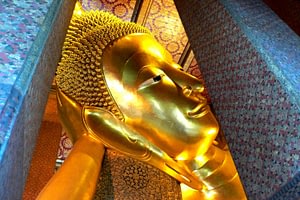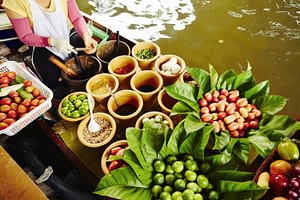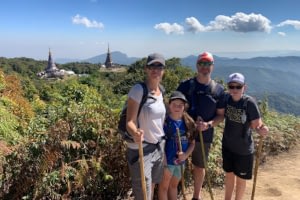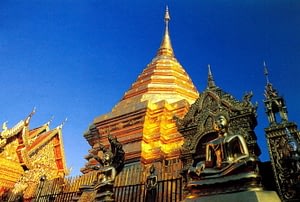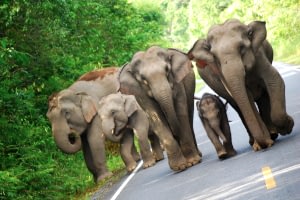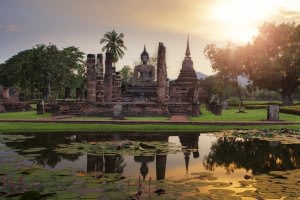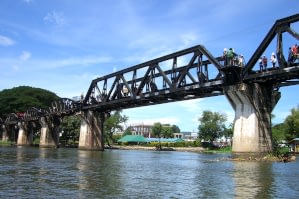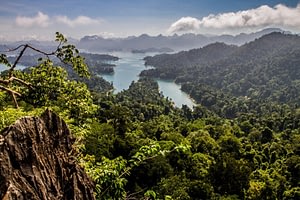Explore the Highlights of Thailand
From paradise islands to hidden hill tribes, read more below about our favourite places and things to discover during a trip to the Land of Smiles. When you're ready to plan your own adventure, packed with Thailand highlights, you can choose from our suggested itineraries and combine with our responsible experiences for a memorable holiday with a positive impact to boot.
Bangkok has changed a great deal in recent years - mostly for the better - with increasing wealth bringing in more people, more jobs and more business, as well as the Sky Train monorail that finally offers its inhabitants a convenient way to escape the infamous traffic. In many ways, though, it remains a restless, cosmopolitan and astonishing city that embraces its past as well as frantic modernity.
At the centre of the old city is the breathtaking Grand Palace and Wat Phra Kaew with its famous Emerald Buddha statue, but it is also home to many other exquisite temples such as Wat Trimit, famous for its solid gold, 3m-high Buddha image, Wat Po with an enormous 45m reclining Buddha and Wat Arun, perched on the riverbank. The newer financial district is where you'll find many international businesses as well as malls, shops and restaurants, while Silom and Sukhumvit are the places to go after dark, when the city really comes alive.
One of the best ways to get a feel for Bangkok is to take one of our walking tours, where a local will guide you down the backstreets and canals to see the real life of the city’s inhabitants and eat at their favourite food stalls hidden away from the crowds. Another is to take a trip on the Chao Phraya river through the heart of the city, especially impressive at night on a dinner cruise. We can also arrange some wonderful bike tours along back lanes into the surprisingly peaceful suburbs that most visitors don't see.
Bangkok is famous for its nightlife and the city offers a wealth of things to do, from nightclubs and bars to cultural shows that showcase the beauty of Thai traditional puppetry and glitzy dance performances featuring dazzling jewelled costumes, ornate headdresses and theatrical masks. A trip to the night market is a must if you want to experience the more down to earth side of Bangkok life, or if you fancy a slice of decadence head to one of the sky lounges for a cocktail on top of a downtown skyscraper. Whatever you do, it’s not long before Bangkok will start to get under your skin!
The floating markets in the countryside outside Bangkok are famous as one of the quintessential Thailand experiences. You’ll have to get up early to catch them at their best, as people come from all over the area to stock up on everything from plastic buckets to exotic fruit before the day begins in earnest. It’s a truly memorable sight to see scores of small sampan boats filling the narrow “klong” (canal), their owners laughing, bartering and swapping their goods from hand to hand in just a few seconds before moving on to the next customer.
After a pick up at 7am from Bangkok or Kanchanaburi, we’ll take you through a varied landscape of salt fields, rice fields, fruit orchards and coconut plantations, stopping to visit a village house to see how brown palm sugar, a key ingredient of Thai cooking, is made from coconut nectar. Once you arrive a the market, you’ll step aboard a traditional longtail boat to see the trading close up and maybe even try your haggling skills. We avoid the commercialised Damnoen Saduak market in favour of the smaller and more authentic ones at Amphawa and Ta Kha, which take place only on weekends and certain days of the lunar calendar, according to Thai tradition.
Another wonderful way to explore this scenic part of the country is to jump on a bike and enjoy canal views and gentle breezes along the river, as you cycle along lush green banks adorned with tropical fruits and fine old typical Thai houses and temples. You'll see none of the hectic modern life of nearby Bangkok, just people living from the produce of their lands flashing you typical Thai smiles as you pass.
One of the biggest highlights of a stay in northern Thailand is the opportunity to visit remote hilltribe villages, to meet people whose way of life has survived mostly unchanged for thousands of years. This unique society includes groups such as Karen, White and Blue Hmong, Mien, Akha and Lisu, each with distinctive clothing, history and rituals.
Visiting one of their villages is a fascinating and eye-opening experience, as you are welcomed into people’s homes to meet their families and share some food, or chat to villagers to find out about their traditions and peaceful rural way of life. Even better is to spend a night with them to share the rhythm of village life and we offer several lodges which are owned and run for the benefit of the community where you can stay.
The spectacular waterfalls, steep valleys and dense jungle of the region are ideal for trekking, both gentle and challenging. It also presents many opportunities for adventure activities, like rafting down mountain rivers on a bamboo raft, biking the trails of Doi Suthep mountain or ziplining… an unforgettable experience as you glide through the canopy, high above the ground.
Inappropriate tourism development over the years has had a negative impact on some hilltribe villages around Chiang Mai and we make every effort to minimise disruption and to ensure our trips are as welcomed by local communities as possible. You can also help by observing some basic customs while you’re there, such as dressing modestly and being careful when taking photos, and your guide will be there to help.
Chiang Mai is renowned as the capital of the ancient kingdom of Lanna – “the land of a million ricefields” - and contains a fine old city surrounded by a moat and some of the most beautiful Buddhist temples in Thailand. Even though it is as the second city of Thailand, Chiang Mai retains its old world charm and its famously easy-going attitude. It also makes a convenient base for your stay in northern Thailand and a starting point for trips out to Chiang Rai, the Golden Triangle and the numerous hilltribe villages that dot the region.
Central to any visit to Chiang Mai are temples and shopping. You can easily spend a couple of days taking in the peaceful atmosphere of Wat Chiang Man or the visual spectacle and elaborate carvings of Wat Phra Singh, as well as sauntering around the remnants of the old city tucked away down back streets. Many people find Chiang Mai a more pleasant place than Bangkok to pick up souvenirs and you will be well-catered for everything from painted fans to furniture.
The other thing Chiang Mai is most famous for is its incredible food, developed from old court recipes, with many popular and delicious dishes originating from here. Learn the secrets of making incredible Thai food on a cooking course, or take a food walking tour with us and you will have the chance to try specialities like the Chiang Mai sausage and khao soi noodle soup - but be prepared for chillies!
There are many trips you can do from Chiang Mai, such as a visit to Wat Phrathad Doi Suthep (built A.D.1384), the most sacred temple in northern Thailand, treks to meet hilltribe people in their traditional villages, or even ziplining and white water rafting. But for many of our customers, the highlight of their visit to Chiang Mai and Thailand is meeting elephants up close and feeding and washing them, at one of the most ethically-run elephant camps in the country. We would also be happy to suggest activities based on your interests like local arts and crafts, cooking or cycling - just let us know and we’ll fix it for you!
Thailand's connection with elephants goes back centuries. They are regarded as a symbol of Thai power and identity, most notably the rare “white elephants” owned by the King, and are still used in important ceremonies such as weddings today. However, in recent times unregulated deforestation severely reduced their habitat and wild populations became unviable, except in a few places. Two are now protected as National Parks at Khao Yai and Kuiburi, which offer the opportunity to see these magnificent animals in their natural habitat just a few hours' drive from Bangkok.
Khao Yai is the more visited of the two but sightings are almost guaranteed because the elephants' habits are well known and the animals closely monitored. A qualified wildlife guide will introduce you to the different kinds of forest found in the park, leading you along old elephant trails to a watchtower to observe the diverse wildlife all around you. You might also be lucky enough to spot some of the sun bears, wild boars, clouded leopards, monkeys, tigers, gaurs or mountain goats that live here. One thing not to miss is a swim in the Haew Suwat waterfall, famous from the movie ‘The Beach’.
Kuiburi, most easily reached from Hua Hin, is home to a herd of around 320 elephants and well as 100 gaur, the biggest buffalo in the world. It is probably one of the easiest places in Thailand to spot large species due to its easily accessible open areas and wild mammals such as leopards, deer, bantengs and langurs are common. Access to the park is only by vehicle with a local guide, keeping visitor numbers down, and for a really wild experience you can even stay overnight in one of the park bungalows.
For a brief but brilliant period of 130 years from 1238-1365, Sukhothai reigned as the most important city in Thailand as it emerged from the weakened grip of the Khmer empire of Cambodia. Before the Sukhothai era there were only tiny competing local fiefdoms, but by the end of his reign King Ramkhamhaeng had conquered almost all of modern day Thailand, leaving as his legacy a unified nation of Thai peoples and a phenomenal artistic heritage.
The Sukhothai (literally, “Dawn of Happiness”) era is traditionally seen as the golden age of Thailand, the beginning of the modern state and the cornerstone of all things Thai. It was in this period that Theravada Buddhism became the main religion of the country and the alphabet was conceived and introduced. Sukhothai was undoubtedly a major spiritual and commercial centre which has left some of the most striking art and architecture in Thailand and grown into one of the country’s most striking historical sites.
The city today is an impressive collection of elegant ruins, which has been designated as a historical park and UNESCO World Heritage Site covering 70 square kilometres. In its heyday it boasted over 40 separate temple complexes, centred around the walled royal city that contains the most important ruins. After years of restoration and jungle clearance, you can now appreciate the keen aesthetic sense of the planners, especially the symmetry and breathtaking use of water to reflect and offset the massive stone temples. We recommend hiring a bike for the day and meandering through the ruins at a leisurely pace – the unexpected sight of a massive Buddha as you round a corner, clad in saffron robes and mirrored in a lotus-filled moat, is one that you won’t forget in a hurry.
The main reason that people visit Kanchanaburi province is to see the infamous bridge over the River Kwai, built by Allied and other prisoners during the Second World War. Over 16,000 POWs from England, Australia, Holland and the USA and 90,000 labourers from Thailand, Myanmar, Malaysia and Indonesia died during the construction of the “Death Railway”, meant to establish supply lines for Japan's newly-captured territories in Burma. Tragically, the railway was only used for 2 years before being torn up for scrap, but the bridge still stands today as a memorial to those who lost their lives.
Depending on your schedule, you can travel from Bangkok by private car, or take the longer but more atmospheric train ride. In Kanchanaburi town, you will visit the moving war cemetery before continuing on to the Hell Fire Pass museum, situated in a cutting through the mountain made by the Allied prisoners. Along a 4km walking trail, visitors can envisage the difficulties faced in constructing the Death Railway using simple tools. The pass is approximately 500m long and 26m deep and was completed within six weeks in 1943 by Australian POWs employing hand drills, picks and shovels, baskets and dynamite. A visit to the museum, which displays contemporary photographs, maps and models from the period, will bring this tragic period of Thai history to life.
As well as history, Kanchanaburi offers wild, untamed forests and rivers with great opportunities for kayaking, mountain biking and wildlife spotting. In nearby Erawan National Park you can trek along a nature trail that winds between massive trees, believed to be protected by spirits, to some splendid waterfalls with emerald-coloured pools suitable for swimming. And for those looking to get away from it all, the Kwai River is also home to some very special floating raft hotels where you can relax completely, immersed in the sounds and smells of the jungle.
Khao Sok National Park, in the south of Thailand, is one of the country's best preserved habitats for tropical plants and wildlife. Within its large boundaries you will find virgin jungle, waterfalls, clear sparkling streams, dramatic limestone cliffs and a wealth of animals and birds. Even better, you can stay in a wooden treehouse perched among the branches, a unique and romantic way to relax and soak up the ambiance of the nature all around you.
The forest is best explored on foot along easy jungle trails, accompanied by an expert guide who will point out the hidden details of the jungle that you might never see on your own - an amazing bird's nest, a giant stick insect or the delicate bloom of a wild orchid. We can also arrange an incredibly relaxing trip down the Klong Sok river by tube or kayak (depending on water levels), which is run by local villagers who want to share and preserve their special environment. The journey takes you past towering cliffs and shoals of river fish and includes as your guide takes care of the paddling, leaving you free to sit back, relax and take in the lush scenery, brightly-coloured birds and monkeys on the shore.
The highlight of most visitors' stay in Khao Sok is a trip to Chiaw Laan Lake, known as “Guilin of Thailand” due to its stunning scenery of limestone islands and cliffs. You can spend a night in this exquisite setting on a basic floating raft house, swimming in the emerald green waters of the lake before enjoying a dinner of southern Thai food and fresh fish, with just the stars and sounds of nature as your backdrop.
And to cap it all off Khao Sok can easily be combined with relaxing on the beach, as it's just a short distance from some fabulous low-key resorts at Khao Lak. Khao Lak is also the jumping off point for scuba diving cruises to the Similan islands, renowned as one of the best dive sites in the world. If it's spectacular natural beauty you're after, Khao Sok should be at the top of your list!

